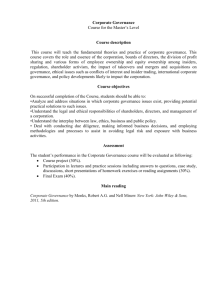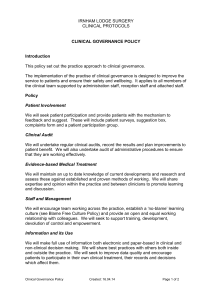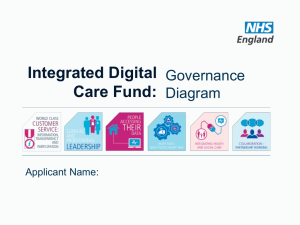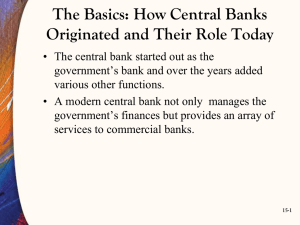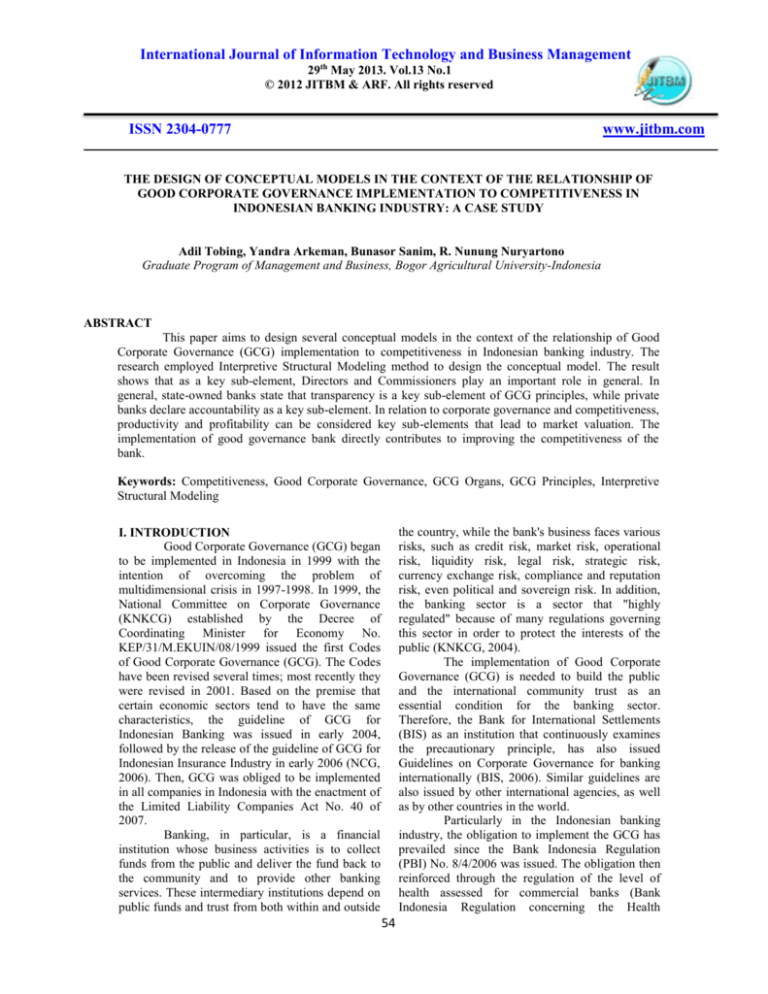
International Journal of Information Technology and Business Management
29th May 2013. Vol.13 No.1
© 2012 JITBM & ARF. All rights reserved
ISSN 2304-0777
www.jitbm.com
THE DESIGN OF CONCEPTUAL MODELS IN THE CONTEXT OF THE RELATIONSHIP OF
GOOD CORPORATE GOVERNANCE IMPLEMENTATION TO COMPETITIVENESS IN
INDONESIAN BANKING INDUSTRY: A CASE STUDY
Adil Tobing, Yandra Arkeman, Bunasor Sanim, R. Nunung Nuryartono
Graduate Program of Management and Business, Bogor Agricultural University-Indonesia
ABSTRACT
This paper aims to design several conceptual models in the context of the relationship of Good
Corporate Governance (GCG) implementation to competitiveness in Indonesian banking industry. The
research employed Interpretive Structural Modeling method to design the conceptual model. The result
shows that as a key sub-element, Directors and Commissioners play an important role in general. In
general, state-owned banks state that transparency is a key sub-element of GCG principles, while private
banks declare accountability as a key sub-element. In relation to corporate governance and competitiveness,
productivity and profitability can be considered key sub-elements that lead to market valuation. The
implementation of good governance bank directly contributes to improving the competitiveness of the
bank.
Keywords: Competitiveness, Good Corporate Governance, GCG Organs, GCG Principles, Interpretive
Structural Modeling
the country, while the bank's business faces various
risks, such as credit risk, market risk, operational
risk, liquidity risk, legal risk, strategic risk,
currency exchange risk, compliance and reputation
risk, even political and sovereign risk. In addition,
the banking sector is a sector that "highly
regulated" because of many regulations governing
this sector in order to protect the interests of the
public (KNKCG, 2004).
The implementation of Good Corporate
Governance (GCG) is needed to build the public
and the international community trust as an
essential condition for the banking sector.
Therefore, the Bank for International Settlements
(BIS) as an institution that continuously examines
the precautionary principle, has also issued
Guidelines on Corporate Governance for banking
internationally (BIS, 2006). Similar guidelines are
also issued by other international agencies, as well
as by other countries in the world.
Particularly in the Indonesian banking
industry, the obligation to implement the GCG has
prevailed since the Bank Indonesia Regulation
(PBI) No. 8/4/2006 was issued. The obligation then
reinforced through the regulation of the level of
health assessed for commercial banks (Bank
Indonesia Regulation concerning the Health
I. INTRODUCTION
Good Corporate Governance (GCG) began
to be implemented in Indonesia in 1999 with the
intention of overcoming the problem of
multidimensional crisis in 1997-1998. In 1999, the
National Committee on Corporate Governance
(KNKCG) established by the Decree of
Coordinating Minister for Economy No.
KEP/31/M.EKUIN/08/1999 issued the first Codes
of Good Corporate Governance (GCG). The Codes
have been revised several times; most recently they
were revised in 2001. Based on the premise that
certain economic sectors tend to have the same
characteristics, the guideline of GCG for
Indonesian Banking was issued in early 2004,
followed by the release of the guideline of GCG for
Indonesian Insurance Industry in early 2006 (NCG,
2006). Then, GCG was obliged to be implemented
in all companies in Indonesia with the enactment of
the Limited Liability Companies Act No. 40 of
2007.
Banking, in particular, is a financial
institution whose business activities is to collect
funds from the public and deliver the fund back to
the community and to provide other banking
services. These intermediary institutions depend on
public funds and trust from both within and outside
54
International Journal of Information Technology and Business Management
29th May 2013. Vol.13 No.1
© 2012 JITBM & ARF. All rights reserved
ISSN 2304-0777
www.jitbm.com
“reliable”. The study results also showed that
69.3% of banks operated in Indonesia had not
complied with corporate governance guidelines,
particularly regarding the necessity of the important
GCG organs in a bank.
Therefore, this paper aims to design
several conceptual models in the relationship of
Good Corporate Governance (GCG) and
competitiveness context in Indonesia banking
industry. This paper will employ case study
approach in several state-owned banks and private
banks using Interpretive Structural Modelling
approach to model the structure.
Assessment for Commercial Bank, Number
13/1/PBI/2011), which was then translated
technically through BI Circular Letter No.
13/24/DPNP dated October 25, 2011 regarding the
Health Assessment for Commercial Banks to all
conventional banks. Then, based on the result of
assessment and the implementation of GCG, the
bank has to restrict the share ownership (Kompas,
2012).
In carrying out its business, the banks
should: adhere to the principle of openness
(transparency); has indicators of performance at all
levels of the bank based on the measures that are
consistent with corporate values, business
objectives and strategy of the bank as a matter of
bank accountability (accountability); adhere to
prudential
banking practices
and
ensure
implementation provisions as a form of bank
accountability (responsibility); be objective and
free from any side pressure in decision-making
(independency); and always consider the interests
of all stakeholders based on the principles of
equality and fairness (fairness) (KNKCG, 2004).
This demonstrates the importance of the
implementation of Good Corporate Governance in
banking institutions in Indonesia and is even linked
to the performance and competitiveness. The
application of BI policy that will evaluate the level
of ownership based on the level of the health and
governance of banks shows that the application of
good governance banking might directly effect to
the level of health or performance of the bank.
Bank Indonesia (BI) also ensures the governance
policy is one way to improve the competitiveness
of the national banking system. BI Governor
proposes seven ways to improve resilience and
competitiveness of the national banking system in
the future, including improving the implementation
of good corporate governance (Putra, 2011).
Several studies have shown the extent to
which the good corporate governance has been
implemented in banking institutions in Indonesia
after the emergence of the rule. Nofianti (2009)
calculated the corporate governance index in 2007,
and the results showed that the highest rank is the
banking sector, that was Bank Mandiri with a score
of 88.66 (very reliable), and Bank Niaga with a
score of 87.90 (very reliable), and at the 9 th and 10th
position in the rank were BNI (79.46) and Bank
Permata (78.85) which had the same predicate,
II. LITERATURE BACKGROUND
2. 1
Good Corporate Governance (GCG)
Corporate governance is associated with
the stewardship theory and agency theory.
Stewardship theory assumes that human beings are
essentially trustworthy, act responsibly, with
integrity and honesty toward others, while agency
theory argues that the company's management as
"agents" for the shareholders will act with full
awareness of its own interests. Conflict of interest
is basically the core of the principal-agency theory
(Jensen and Meckling, 1976; Leibenstein, 1966).
Corporate governance is essentially all
efforts made to resolve conflicts of interest that
occur in the company (agency problems).
Furthermore, various studies on corporate
governance developed based on agency theory in
which management is conducted with full
compliance to the various rules and regulations to
address conflicts of interest. The concept of Good
Corporate Governance (GCG) began to be known
since the 1990's and the OECD countries began to
practice it around the year of 1999 (Kaihatu, 2006).
Good Corporate Governance (GCG) is a
concept of good governance practices in an
institution in which there is the principle of
transparency,
accountability,
responsibility,
independence, and fairness that needs to be carried
out by an institution (BI, 2006). OECD defines
corporate governance as a set of relationships
between the company's management, board of
directors, shareholders, and other stakeholders
(BIS, 2006). In the GCG organs, each stakeholder
has their own interests, such as:
a. Shareholders, with the interest in dividends and
capital gains.
55
International Journal of Information Technology and Business Management
29th May 2013. Vol.13 No.1
© 2012 JITBM & ARF. All rights reserved
ISSN 2304-0777
www.jitbm.com
b.
Employees, with the interest in the salary,
benefits package, and a good working
environment.
c. Creditors, with the interest in the company's
ability to repay debt.
d. Suppliers, with the interest in maintaining the
company as a subscription.
e. Customer / Debtors, with interest in receiving
financing facilities and services.
f. The Government, with the interests in the tax
revenue.
g. Society, with an interest in the benefits to the
region.
h. Other groups with an interest in the oversight
of corporate actions.
The company organs included of the
general meeting of shareholders (Annual General
Meeting/AGM), the Boards (Commissioners and
Directors) have an important role in the
implementation of GCG. The organs shall perform
its functions in accordance with the applicable
provisions on the principle that each organ has
independence in carrying out the duties, functions
and responsibilities solely for the benefit of the
company.
efficiency while ensure quality of service to the
customers.
Claessens and Laeven (2003) study which
estimate the degree of competition in the banking
system in 50 countries shows that a banking system
which has more open system for foreign banks to
enter (not overly restrict the entry of foreign banks)
has a higher level of competitiveness. However, it
is found that the banks’ concentration will be
negatively related to competitiveness. Therefore,
Claessens and Laeven results confirm that
contestability (criteria to limit the banks to provide
other financial services and test the suitability of
the banking market entry (entry fitness test)) helps
to determine the effective competition, particularly
through ease of foreign banks to entry. However,
some studies are actually found that opening the
foreign investment more freely will not directly
have implications on the performance of local
banks.
Zhu (2007) finds that the efficiency cannot
be obtained "immediately" with the entry of foreign
banks in the developing countries, but there are
possible efficiency gains, only on a competitive
banking environment. Genc (2005) argue that the
positive implication of foreign banks to local banks
includes the efficiency spill-over in improving the
performance of local banks. The local banks
usually have some obstacles including lack
institutional environment that limit the development
of the market, lack protection against property
rights, and corruption (in particular).
The
essence
of
improving
the
competitiveness of banking institutions as assessed
by Priyanto (2006) is the reduction of costs and the
increase of profitability indicators. Banks will also
be seen through the indicators of market share
because it is a reflection of customer trust to use the
banking services. In addition, a bank also needs to
be different (differentiated) compared to its
competitors.
In
Priyanto’s
study,
bank
competitiveness factor includes market share and
profit growth. The results of the study finally show
that competitiveness (particularly bank merger) is
influenced by the healthiness and efficiency of the
bank.
Related to this, if the measures of
competitiveness according to Priyanto (2006) are
the market share and profit growth, one of the
parameters that can be used related to the
2.2 Competitiveness
Operational effectiveness is not enough to
face competition nowadays (Porter, 1996).
Companies need to do more than just achieving
operational effectiveness in terms of performance.
Companies need to develop a competitive strategy
that will make the company different from its
competitors. The initial concept of competitiveness
was developed by Porter. Porter (1990) states that a
country's competitiveness is determined by its
ability to innovate and upgraded. In addition, Porter
also argues that competitiveness can be viewed
through the company-owned competitive advantage
against its competitors, through a cost advantage
and differentiation, with the main elements of
productivity.
The highly regulated banking institutions
need to embody, enhance and ensure the
sustainability of competitive advantage (sustainable
competitive advantage) through competitive
strategies by determining its strategic position
(Porter, 1996). Banking institutions that supposed
to remain highly leveraged have to improve
56
International Journal of Information Technology and Business Management
29th May 2013. Vol.13 No.1
© 2012 JITBM & ARF. All rights reserved
ISSN 2304-0777
www.jitbm.com
performance in the market is market value. Many
studies use this parameter to see the performance of
banks, including Klapper and Love (2002) and
Brown and Caylor (2006). Both of these studies use
Tobin's-Q, which is a measure of companies’
performance in the market which is the sum of the
market value of equity and total liabilities divided
by total assets. Klapper and Love (2002) even state
that compared to return as a measure, Tobin's-Q is
better because of the economic volatility that
occurred in developing countries. In addition,
Tobin's-Q is also used by researchers as a measure
of firm valuation implications for the
implementation of GCG.
Meanwhile, Al-Swidi and Mahmood
(2011) asserts that banking institutions are
customer-centric (customer focus) that need to
increase its competitive advantage. In fact, AlSwidi and Mahmood find that organizational
culture is a source of competitive advantage.
Therefore, the GCG as a form of intervention for
organizational culture has an important role to
increase the competitiveness of banking system, of
course, by realizing its competitive advantage.
factors, Jharkaria (2011) who identify and designate
the main factors of ERP implementation failure,
Kanungo and Van (2009 ) to identify shared mental
models in information systems research, Sagheer et
al (2009) which identifies and analyzes major
factors affecting compliance standards and level
relationship in the food industry of developing
countries, Salimifard et al (2010) that identifies
critical success factors rekaysasa project on
banking business processes, Tabrizi et al (2010)
that build relationships between the criteria for
measuring the results of knowledge management
(KM) has implications for the successful
implementation of KM, Wan et al (2010) that
identify and model the structure of the business
risk, and the newest study by Astuti et al (2013)
that clarify and analyze the risk mitigations in the
supply chain of mangosteen.
In general, based on several studies (Astuti
et al, 2013, Jharkharia, 2011; Kanungo and Van,
2009; Sagheer et al, 2009; Salimifard et al, 2010;
Tabrizi et al, 2010; Wan et al, 2010), measures the
relationship in a system identification complex with
the ISM method are:
1. Identify the elements of the system that can be
carried out through research, brainstorming or
other.
2. Determine the contextual relationship between
elements in accordance with the objectives.
3. Structurally form the Self Interaction Matrix
(SSIM), which is the result of respondents'
perceptions of expert contextual relationship
between elements or between sub-elements.
4. Form Reachability Matrix (RM), which is the
conversion of a binary matrix SSIM.
5. Make level partitioning which classifies
elements into different levels of the ISM
structure to be formed.
6. Form the grouping canonical matrix elements
with the same level
7. Develop the digraph which is a chart of the
elements are interconnected directly, and levels
of hierarchy.
For the research purpose, in the
relationship of GCG and competitiveness context,
we develop general elements, namely the Actors,
the Objectives, the Benchmarks, and the
Constraints. The Actors element consists of sub
elements of GCG organs, as mention in Table 1,
while the objectives element consists of sub
III. METHODOLOGY
This study used primary data through the
instrument of questionnaires and interviews to
GCG organ. The samples are selected from three
largest state-owned banks (SOEs), namely Bank
Mandiri, BRI and BNI, and two private banks,
namely BCA and Bukopin. The samples choice are
based on purposive sampling because the
respondents had to be part of the GCG organ and it
was not possible to randomly selected. Then, the
experts were asked to give their perception/opinion
regarding all variable or sub elements mentioned in
the questionnaire.
Furthermore, to create conceptual models,
Interpretive Structural Modeling (ISM) was
employed. ISM is a method used to deal with
complex issues (Janes, 1988). Input in the ISM is
the knowledge and perceptions of different from
each participant. ISM benefits include a more
focused debate, clarification of thinking, group
learning, and team building. ISM also produces
visual models making it easier to understand.
Several studies have used various methods of ISM
for different cases, including Gorvett and Liu
(2007) which describes the relationship of risk
57
International Journal of Information Technology and Business Management
29th May 2013. Vol.13 No.1
© 2012 JITBM & ARF. All rights reserved
ISSN 2304-0777
www.jitbm.com
elements of competitiveness, as mention in Table 2.
Meanwhile, the benchmarks element consists of sub
elements of GCG principles, as mention in Table 3,
while Table 4 shows the constraints elements.
the market value of equity and total liabilities
divided by total assets.
Table 2. Objectives Element (Competitiveness)
Table 1. Actors Element (GCG Organ)
OBJECTIVES (COMPETITIVENESS)
ACTOR (GCG ORGAN)
1
2
3
4
5
6
7
8
9
10
11
12
13
14
15
16
Efficiency (cost
advantage)
Shareholders
Board of Commissioner
Board of Director
President Director
Director/Head of Finance Division
Director/Head of Compliance Division
Director/Head of Credit Division
Corporate Secretary
Internal Control Unit
GCG Committee
Audit Committee
Risk Management Committee
Nomination Committee
Remuneration Committee
Employee union
Customer
Productivity
BOPO
Market share of TPF
Market share of Credit
Market share of Asset
Profitability
Profit growth
Market valuation
Tobin's Q
Then, the benchmarks element, namely
GCG principles, is a group of GCG principles
based on National Committee in Corporate
Governance (KNKCG). Several principles are
explained below (KNKCG, 2004):
1. Disclosure (Transparency)
Banks should disclose information in a timely,
appropriate, clear, accurate and comparable
manner, and easily accessible to stakeholders
in accordance with their rights; information
that must be disclosed include but are not
limited to matters related to the vision,
mission, business objectives and corporate
strategy, financial condition, composition and
compensation of management, controlling
shareholders, cross shareholding (public
company has shares in other public
companies),
executive
officers,
risk
management, monitoring systems and internal
controls, compliance status, system and
implementation of GCG and important events
that may affect the condition of the bank; the
transparency principle adopted by the bank
does not reduce the obligation to comply with
bank secrecy in accordance with the
legislation, and personal rights; bank's policy
must be written and communicated to
interested parties (stakeholders) including the
rights to obtain information about the policy.
2. Accountability
Banks should establish clear responsibilities of
each organ of the organization aligned to the
Meanwhile, the objectives element,
namely competitiveness elements includes several
variables that are supporting competitiveness of a
bank based on the literature review. First, efficiency
is represented by BOPO, the ratio of operating
expenses to operating income. Second, productivity
is represented by market share of deposits (third
party fund/TPF), market share of credit, and market
share of asset. Market share of TPF is the
percentage of deposits that are managed by one
bank compared to the total amount of deposits by
all banks in a country, while market share of credit
is the percentage of loans that are delivered by one
bank compared to the total amount of loans by all
banks in a country. Similarly, market share of asset
is the percentage of assets managed by the bank
compared to the total amount of assets by all banks
in a country. Third, profitability is represented by
the growth of profit in a bank. Fourth, the market
valuation is represented by Tobin's-Q, the sum of
58
International Journal of Information Technology and Business Management
29th May 2013. Vol.13 No.1
© 2012 JITBM & ARF. All rights reserved
ISSN 2304-0777
3.
4.
5.
www.jitbm.com
vision, mission, business objectives and
strategy; banks must ensure that all bank organ
has competence in accordance with its
responsibilities and understand their role in the
implementation of GCG; banks should ensure
the presence of check and balance system in
the management of the bank; banks must have
a such level of performance based on the
agreed measures and consistent with the value
of the company (corporate values), business
objectives and strategy of the bank and has a
rewards and punishment system.
Responsibility
To maintain the continuity of their business,
banks must hold on to the precautionary
principle (prudential banking practices) and
ensure the implementation of regulations; bank
should act as a good corporate citizen (good
company),
including
caring
for
the
environment and fulfilling its social
responsibility.
Independency
Banks should avoid unfair domination by any
stakeholder and is not affected by the unilateral
interests and free from conflict of interest; bank
decisions should be objective and free from
any pressure from any party.
Fairness
Banks should always take into consideration
the interests of all stakeholders based on the
principles of equality and fairness (equal
treatment); banks should provide an
opportunity to all stakeholders to provide input
and expression for the benefit of the bank.
constraints considered as factors which be able to
be obstacles in the implementation of GCG
primarily related to the context of the relationship
to the competitiveness.
Table 4. Constraints Element
CONSTRAINTS
1
2
3
4
5
6
7
8
IV. RESULT AND ANALYSIS
In order to design conceptual models in
the relationship among the sub elements of GCG
and competitiveness based on those actors,
objectives, benchmarks, and constrains elements,
Interpretive Structural Modeling was employed
with the steps as follow:
1. Identify the elements of the system that is
carried out through designed questionnaire
with the expert from five banks mentioned
above.
2. Determine the contextual relationship between
elements in accordance with the objectives
based on specific rules, including:
3. V: If the sub-element to the i-th (row / left) is
more dominant than sub-element to the j-th
(column / upper)
4. A: If the sub-element to the j-th to is more
dominant than the sub element to the i-th
5. X: If the sub elements to the i-th and subelements to the j-th is equally dominant
6. O: If the sub elements to the i-th and subelements to the j-th is equally not dominant
7. Structural formation of Self Interaction Matrix
(SSIM), which is the result of respondents'
perceptions of expert contextual relationship
between sub-elements, as below:
Table 3. Benchmarks Element GCG Principles)
BENCHMARKS (GCG Principles)
1
Transparency
2
Accountability
3
Responsibility
4
Independency
5
Fairness
At last, for the constraints element, based
on focus group discussion with limited number of
experts in GCG practices, several significant
a.
Lack of commitment
Lack of leadership
Too much intervention
Conflict of interest
Reward & punishment not executed
Group resistance
Too much and obstructed regulation
Ownership factor
Actors
59
International Journal of Information Technology and Business Management
29th May 2013. Vol.13 No.1
© 2012 JITBM & ARF. All rights reserved
ISSN 2304-0777
www.jitbm.com
Bank Mandiri
BRI
BNI
60
International Journal of Information Technology and Business Management
29th May 2013. Vol.13 No.1
© 2012 JITBM & ARF. All rights reserved
ISSN 2304-0777
www.jitbm.com
BCA
b.
Objectives
Bank Mandiri
BCA
c.
Bukopin
BRI
BNI
Bukopin
Benchmarks
Bank Mandiri
BRI
BNI
61
International Journal of Information Technology and Business Management
29th May 2013. Vol.13 No.1
© 2012 JITBM & ARF. All rights reserved
ISSN 2304-0777
BCA
d.
www.jitbm.com
Bukopin
Constraints
Bank Mandiri
BCA
8.
BRI
BNI
Bukopin
Formation Reachability Matrix (RM), which is the conversion of a binary matrix SSIM.
a. Actors
Bank Mandiri
BRI
62
International Journal of Information Technology and Business Management
29th May 2013. Vol.13 No.1
© 2012 JITBM & ARF. All rights reserved
ISSN 2304-0777
www.jitbm.com
BNI
BCA
b.
Bukopin
Objectives
Bank Mandiri
BRI
63
BNI
International Journal of Information Technology and Business Management
29th May 2013. Vol.13 No.1
© 2012 JITBM & ARF. All rights reserved
ISSN 2304-0777
BCA
c.
Bukopin
Benchmarks
Bank Mandiri
BCA
d.
www.jitbm.com
BRI
BNI
Bukopin
Constraints
Bank Mandiri
BRI
BCA
Bukopin
64
BNI
International Journal of Information Technology and Business Management
29th May 2013. Vol.13 No.1
© 2012 JITBM & ARF. All rights reserved
ISSN 2304-0777
9.
www.jitbm.com
Digraph which is a chart of the elements that are interconnected directly, and levels of hierarchy.
a. Actors
Bank Mandiri
BRI
65
BNI
International Journal of Information Technology and Business Management
29th May 2013. Vol.13 No.1
© 2012 JITBM & ARF. All rights reserved
ISSN 2304-0777
www.jitbm.com
BCA
Bukopin
Legend:
ACTOR (GCG ORGAN)
1
2
3
4
5
6
7
8
9
10
11
Shareholders
Board of Commissioner
Board of Director
President Director
Director/Head of Finance Division
Director/Head of Compliance Division
Director/Head of Credit Division
Corporate Secretary
Internal Control Unit
GCG Committee
Audit Committee
66
International Journal of Information Technology and Business Management
29th May 2013. Vol.13 No.1
© 2012 JITBM & ARF. All rights reserved
ISSN 2304-0777
12
13
14
15
16
www.jitbm.com
Risk Management Committee
Nomination Committee
Remuneration Committee
Employee union
Customer
b. Objectives
Bank Mandiri
BCA
BRI
Bukopin
Legend:
OBJECTIVES (COMPETITIVENESS)
Efficiency (cost advantage)
BOPO
Productivity
Market share of TPF
67
BNI
International Journal of Information Technology and Business Management
29th May 2013. Vol.13 No.1
© 2012 JITBM & ARF. All rights reserved
ISSN 2304-0777
www.jitbm.com
Market share of Credit
Market share of Asset
Profitability
Profit growth
Market valuation
Tobin's Q
c. Benchmarks
Bank Mandiri
BRI
BNI
BCA
Bukopin
Legend:
BENCHMARKS (GCG Principles)
1
Transparency
68
International Journal of Information Technology and Business Management
29th May 2013. Vol.13 No.1
© 2012 JITBM & ARF. All rights reserved
ISSN 2304-0777
2
Accountability
3
Responsibility
4
Independency
5
Fairness
www.jitbm.com
d. Constraints
Bank Mandiri
BRI
BCA
Bukopin
Legend:
CONSTRAINTS
1
2
Lack of commitment
Lack of leadership
3
Too much intervention
4
5
Conflict of interest
Reward & punishment not executed
69
BNI
International Journal of Information Technology and Business Management
29th May 2013. Vol.13 No.1
© 2012 JITBM & ARF. All rights reserved
ISSN 2304-0777
6
7
8
www.jitbm.com
Group resistance
Too much and obstructed regulation
Ownership factor
In aggregate, the result varies for each bank in
each element. On the actor elements, only Bank Mandiri
that clearly has a Corporate Governance Committee.
Therefore, the key element in the relationship between
the implementation of good corporate governance and
competitiveness is a GCG Committee. BRI and BNI have
a key sub-element of the Director/Head of Compliance,
while at BCA and Bukopin, the key sub-element is the
Board of Commissioner.
On the objective elements, according to
Bukopin BOPO is a key sub-element. Almost all stateowned banks state that market share of deposit is a key
sub-element, except BRI. Meanwhile, market share of
credit is a key sub-element for Bank Mandiri, BRI and
Bukopin. Profitability is a key sub-element for Bank
Mandiri, BRI and Bukopin. In general, productivity and
profitability can be considered key sub-elements that
leads to market valuation.
In the benchmark elements, state-owned banks
(Mandiri, BRI, BNI) state that transparency is a key subelement. Meanwhile, Bank Mandiri and BCA state that
accountability is a key sub-element. Bank Mandiri and
Bukopin claim responsibility as a key sub-element.
On the constraint elements, lack of commitment
as a key sub-element is expressed by BRI and Bukopin,
while lack of leadership as a key sub-element is
expressed by BNI and BCA. Too much intervention and
regulations as a key sub–element are stated by BNI.
Conflict of interests as a key sub-element is expressed by
BCA. However, there are no obstacles that hinder GCG
implementation at Bank Mandiri.
Overall, in terms of GCG implementation, only
3 principles mostly turn out to be the key elements,
namely transparency, accountability, and responsibility.
However, the whole five principles of good corporate
governance should have played the same role as key subelements. Director as a key organ is very appropriate
since the Board of Directors lead the management of the
company and are fully responsible for the performance of
the company. Corporate Governance Committee is
institutionalized as a key organ in each bank as the Bank
Mandiri has done. Corporate Governance Committee will
be an independent organ and a driving force in helping
the Board of Directors disseminate and implement GCG,
as well as evaluate the implementation of GCG in a bank.
GCG Committee should be under the Board of
Commissioners (whose primary task is represent
shareholders in supervising the management of the
company/bank led by the Board of Directors).
With GCG, applying the main principles of transparency
means that management has to always provide material
and relevant information to shareholders and
stakeholders
for
decision
making;
likewise,
accountability means that management should be
accountable for its performance to shareholders and
stakeholders. These will decrease inherent risk profile of
the bank, increase profitability that will strengthen the
bank's capital and improve the investors’ confidence
(improved performance).
V. CONCLUSION
As a key sub-element, Directors and
Commissioners play an important role in general.
However, in the context of the relationship of GCG
implementation to competitiveness Bank Mandiri is
different with other banks because only Bank Mandiri
that has GCG committee which is a key sub-element.
Meanwhile, in terms of good corporate governance
principles, the difference between state-owned and
private bank can be seen in the key sub-element they
choose. In general, state-owned banks state that
transparency is a key sub-element, while private banks
declare accountability as a key sub-element. In relation to
corporate governance and competitiveness, productivity
and profitability can be considered key sub-elements that
lead to market valuation.
The implementation of good governance bank
directly contributes to improving the competitiveness of
the bank. The depositors will feel safe to put their money
in banks that apply the principles of good corporate
governance. The debtors would also be supported by a
bank run in a transparent and accountable way. These
results in the growth of market share of Third Party
Funds (TPF) and the market share of credit delivered to
society.
The growth market share of deposits and loans
will increase the income growth generated annually.
70
International Journal of Information Technology and Business Management
29th May 2013. Vol.13 No.1
© 2012 JITBM & ARF. All rights reserved
ISSN 2304-0777
www.jitbm.com
Henceforth earnings growth will increase the bank's
share value in the eyes of investors. The improvement of
these three elements (productivity, profitability, and
market valuation) will contribute significantly to
improving the competitiveness of the bank.
In general, the implementation of GCG in
Indonesian banks has progressed, especially with law
enforcement by the application of Bank Indonesia
Regulation No. 08/04/2006 and PBI 8/14/GCG/2006, and
the Decree of Minister of State 117/M-MBU / 2002 on
the implementation of good corporate governance
practices in SOEs (including state-owned banks).
However, its application in limited liability banks is still
lagging behind the banks which have sold their shares in
the stock of capital markets. The element of transparency
and independence as the guiding principles of good
corporate governance has not been implemented by
limited liability banks because the intervention of the
owners is still quite strong.
The number of 120 banks operating in Indonesia
is still so many that Bank Indonesia Regulation require
small banks that have limited capital base to merge
together as a solution for reducing the sole ownership of
the banks, and pave the way for public ownership, which
is believed to be very effective for monitoring the
implementation of GCG in each bank.
Bank is a business of trust. Without the element
of trust, it is impossible for depositors to put their money
in banks that they doubt its creditworthiness. So do the
vendors and debtors; they expect that they can work
together with the bank; they need to believe that the bank
will support them not only during periods of favorable
but also especially during difficult times. The
implementation of GCG in a bank clearly gives a positive
perception for the lenders and investors in the presence
of indicators of competitiveness that increases the
productivity, profitability, and market valuation.
By the analysis and conclusions, several good
suggestions which have implication on management and
further research can be made. Bank Mandiri, as the
largest state-owned banks, has gone a step further by
establishing a corporate governance committee.
Therefore, it is recommended that the management of
other state-owned banks (BRI, BNI and BTN) and other
national private banks immediately form a special
committee to pay more attention on the implementation
of GCG on each bank. In addition, it is suggested that
self-assessment of GCG is conducted independently and
if necessary, assisted by an independent reviewer.
References
Al-Swidi, AK. Rosli Mahmood. 2011. Enhancing A
Bank’s Competitive Advantage through the
Integration of TQM Practices, Entrepreneurial
Orientation (EO), and Organizational Culture.
European Journal of Social Sciences.Volume 20,
Number 2
Astuti, M, Marimin, M, Arkeman, Y, Purwanto, R,
Meuwissen, MPM. 2013. Risks and Risks
Mitigations in Manggosteen Supply Chain: A Case
Study.
Operations
and
Supply
Chain
Management.Vol. 6. No.1. pp.11-25
[BI] Bank Indonesia. 2011. Statistik Perbankan
Indonesia.Vol. 10. No. 1.bulan Desember
[BIS] Bank for International Settlements. 2006.
Enhancing Corporate Governance for Banking
Organisations
Bapepam-LK.2010. Kajian tentang Pedoman Good
Corporate Governance di Negara-Negara Anggota
ACMF
Claessens, S. 2006. Corporate Governance and
Development. The World Bank Research Observer
Advance Access. Published by Oxford University
Press
Claessens, S. Luc Laeven. 2003. What Drives Bank
Competition? Some International Evidence
Cornellius, Peter. Governance Good corporate practices
in poor corporate governance systems. Corporate
Governance,Vol. 5. No. 3:12-23,
Gorvett, Rick. Ningwei Liu. 2007. Using Intepretive
Structural Modeling to Identify and Quantify
Interactive Risks. ASTIN Colloquium Call for
Papers. Orlando
Janes, FR. 1988 Interpretive Structural Modelling (ISM):
a methodology for structuring complex issues.
Trans Inst MC. Vol 10. No 3
Jensen, MC, WH Meckling. 1976. Theory of the Firm:
Managerial Behavior, Agency Costs and
Ownership Structure. Journal of Financial
Economics, Vol. 3, No. 4, pp. 305-360.
Leibenstein, H. 1966. Allocative efficiency vs Xefficiency. The American Economic Review. Vol.
56:3
Kaihatu, TS. 2006. Good Corporate Governance dan
Penerapannya di Indonesia. Jurnal Manajemen dan
Kewirausahaan.Vol.8. No.1:1-9
Kanungo, S. V Jain. 2009. Using Intepretive Structural
Modeling to Uncover Shared Mental Models in IS
71
International Journal of Information Technology and Business Management
29th May 2013. Vol.13 No.1
© 2012 JITBM & ARF. All rights reserved
ISSN 2304-0777
www.jitbm.com
Research. European Conference on Information
System. June 8-10. Verona, Italy
[KNKCG] Komite Nasional Kebijakan Corporate
Governance.2004. Pedoman Good Corporate
Governance Perbankan Indonesia.Komite Nasional
Kebijakan Governance, Jakarta.
[KNKG] Komite Nasional Kebijakan Governance.2006.
Pedoman Umum Good Corporate Governance
Indonesia.
Komite
Nasional
Kebijakan
Governance, Jakarta.
Kompas. 2012. Tata Kelola Perbankan Jadi Acuan:
Bank BUMN dikecualikan. Terbit Selasa, 5 Juni
2012. Hal 19
[KPK] Komisi Pemberantasan Korupsi. 2010. Studi
Implementasi Good Corporate Governance di
Sektor Swasta, BUMN dan BUMD. Diakses pada
tanggal
21
November
2012:
http://www.kpk.go.id/modules/PDdownloads/single
file.php?cid=8&lid=55
Nofianti, Leny. 2009. Penerapan Good Corporate
Governanca di Indonesia. Jurnal Akuntansi dan
Keuangan. Vol. 14. No.2
Putra, I Rusadi. 2011.7 Cara Jitu Naikkan Daya Saing
Perbankan. Okezone. 21 Januari 2011
Porter, Michael E. 1996. What is Strategy? Harvard
Business Review.November-Desember
Sagheer, Silpa. SS Yadav. SG Deshmukh. 2009. An
Application of Intepretative Structural Modeling of
the Compliance to Food Standards. International
Journal of Productivity and Performance
Management. Vol. 58. No. 2. pp.136-159
Saidi, Nasser. 2007. Linking Governance and
Competitiveness, Oman Economic Association
Conference Muscat. Oman March 24-25, 2007
Salimifard, Khodakaram. Mohammad Ali Abbaszadeh.
Ahmad Ghorbanpur. 2010. Intepretive Structural
Modeling of Critical Success Factors in Banking
Process Re-engineering. International Review of
Business Research Papers. Vol. 6. No.2. pp.95-103
Scott, David H. 2007. Strengthening the Governance and
Performance of State-Owned Financial Institutions.
Policy Research Working Paper 4321. The World
Bank
Sukasih, Ni Ketut, Ni Luh Nyoman Ayu Suda Susilawati.
2011. Dampak Good Corporate Governance (GCG)
terhadap Kinerja Perusahaan (Studi Kasus di Bursa
Efek Indonesia). Jurnal Bisnis dan Kewirausahaan.
Vol. 7. No. 3
Tabrizi, RS. Yeap Peik Foong. Nazli Ebrahimi. 2010.
Using Intepretive Structural Modeling to Determine
the Relationship Among Knowledge Management
Criteria Inside Malaysian Organizations. Wolrd
Academy of Science, Engineering Technology. Vol.
72
Wan, Jiangping. Dan Wan. Hui Zhang. 2010. Case Study
on Business Risk Management for Software
Outsourcing Service Provider with ISM.
Technology and Investment. Vol. 1. pp. 257-266
Zhu, Lili. 2007. Impact on Foreign Entry on Banks in
Emerging Market: The Role of the Pre-existing
Competitive Environment. Disertation. Department
of International Business, the School of Business,
the George Washington University
72


